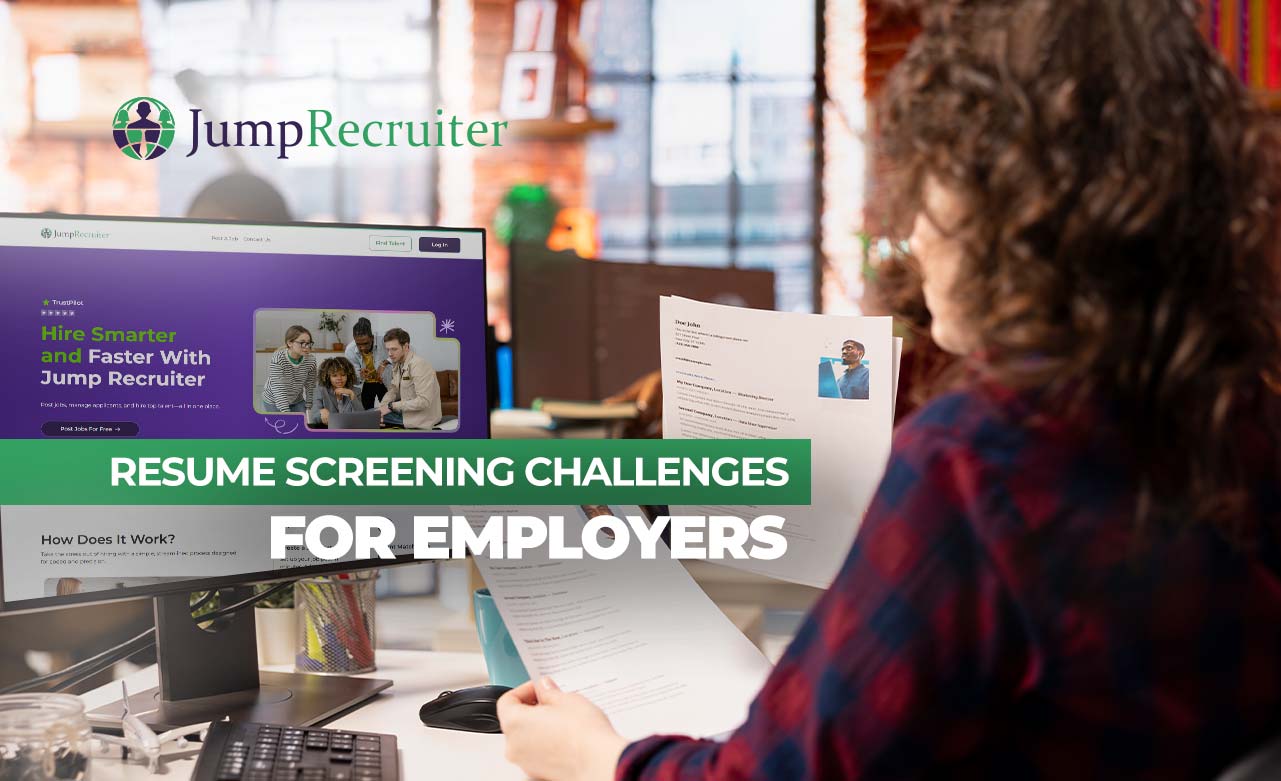“Call Out: Your resume isn’t a story you tell—it’s a signal you send. If something smells off, recruiters will smell it too.”
Your resume often faces a blink test. In 7.4 seconds, many recruiters decide whether to dig deeper. One small red flag can shift that decision against you.
But not all red flags are fatal. Sometimes you can explain, soften, or correct them. This blog will help you spot lethal mistakes, understand why hiring managers react, and — most importantly — repair or neutralize red flags.
Let’s dig in.
Why Employers Look for Resume Red Flags
Hiring managers and recruiters are trained to spot top resume mistakes job seekers must avoid. They look for these signals not because they want to reject candidates, but because they must protect their company from bad hires. A wrong hire costs money, time, and team morale.
When scanning resumes, they use three quick checks:
- Pattern check: Does this resume look like the ones of top performers they’ve hired before?
- Risk filter: Are there signs of gaps, job hopping, or exaggeration that may signal future problems?
- Trust factor: Do dates, roles, and results match up with LinkedIn or cover letters?
Understanding this helps you write a resume that passes these filters. The more trust you build in seconds, the better your chances of getting an interview.
13 Resume Red Flags to Avoid
We all know that most recruiters and hiring managers are qualified enough to spot trouble in seconds. According to a study reported by HR Dive, recruiters often spend as little as 7.4 seconds reviewing a resume. They scan resumes for patterns that indicate risk, and when they see specific signals, they pause or proceed. These red flags are not just about mistakes; they’re warning signs that make a hiring team think twice about calling you.
The good news? Most of these red flags can be fixed or explained if you know how. Below, we’ll break down the top resume mistakes job seekers must avoid, why they scare employers, and exactly how to turn them into opportunities.
Think of this section like a map — every point you fix removes a roadblock between you and the interview.
1. Unexplained Employment Gaps
Employment gaps are one of the first things recruiters notice. A blank space between jobs makes them wonder — were you unemployed, fired, or inactive? Did you lose touch with your skills?
Instead of leaving a gap empty, explain it briefly. Show that you used the time productively. Even personal growth counts if it connects to your career.
How to Fix It:
- Add a one-line explanation for the gap.
- Highlight learning, certifications, volunteer work, or freelance projects.
- Keep it short and professional.
Example: Career Break (06/23 – 12/23)
• Completed Google Data Analytics Certificate
• Freelanced for two local businesses
• Volunteered as Social Media Manager for NGO
This turns a “gap” into a story of growth and self‑improvement.
2. Frequent Job Hopping Without Growth
Jumping between too many jobs in a short time can make recruiters nervous. They might think you get bored quickly, can’t commit, or have trouble working with teams.
But job changes aren’t always bad — sometimes they show ambition or contract work experience. The key is to tell the right story.
How to Fix It:
- If you have worked on short-term contracts, group them under one heading, such as “Freelance Projects” or “Consulting Roles.”
- Show how each job added a new skill or responsibility.
- Highlight promotions or bigger roles to show upward movement.
Example: A Freelance Marketing Consultant From 2021 to 2023
• Delivered 8+ projects for startups in tech and retail
• Increased social media engagement by 40% for three clients
• Built expertise in paid ad campaigns and influencer partnerships
In this way, job hopping is viewed as a symbol of flexibility and consistency in value.
3. Generic or AI‑Generated Content
Recruiters see hundreds of resumes every day. If yours reads like it was copied from a template or generated with no personal touch, it blends in — and gets ignored.
Buzzwords like “hard-working,” “results-driven,” and “team player” may sound good, but they convey little meaning. AI‑generated resumes can also look too polished and soulless — missing your unique voice.
According to a study by the National Bureau of Economic Research (NBER), applicants who tailor their resumes to the specific job posting tend to receive more interview opportunities than those who submit generic applications. This demonstrates that personalization isn’t just nice to have — it has a direct impact on results.
How to Fix It:
- Write in simple, human language. Use words you’d actually say.
- Add numbers, percentages, and real results to make achievements stand out.
- Replace clichés with specific actions.
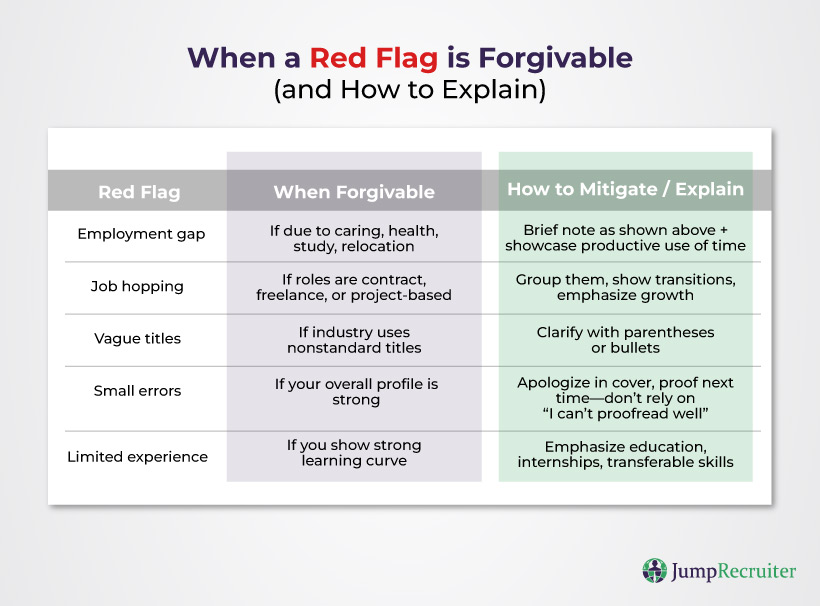
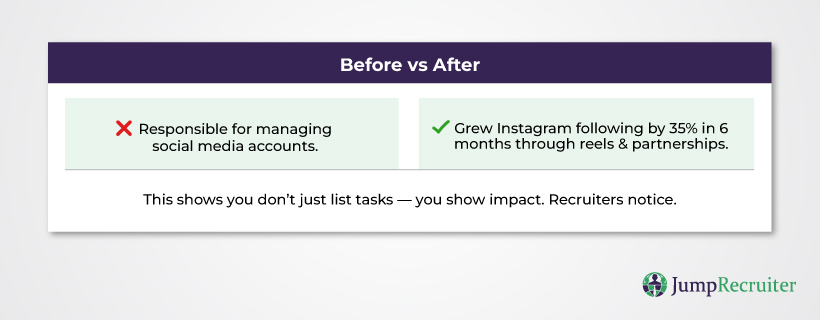
4. Vague Job Titles
Job titles that are too creative or unclear confuse recruiters. A title like “Sales Ninja” or “Growth Wizard” might sound fun, but it leaves hiring managers guessing what you actually did.
Recruiters search for familiar titles to match job descriptions. If your title doesn’t match, you might miss keyword filters or get skipped.
How to Fix It:
- Use standard industry titles or clarify your role in parentheses.
- If your company used unusual titles, rewrite them in a way that still reflects your level.
- Keep it honest — don’t inflate your position.
Example:
Original Title: Brand Rockstar
Better Title: Brand Manager (Marketing Specialist)
This minor tweak makes your resume instantly clearer — and gets you past applicant tracking systems (ATS).
5. Responsibilities Without Achievements
Listing job duties alone makes your resume sound like a job description, not a success story. Recruiters want to know what you did with those responsibilities — and whether you made an impact.
When every bullet just says what you were “responsible for,” it hides your results and makes your experience look flat.
How to Fix It:
- Turn duties into accomplishments by adding numbers, percentages, or outcomes.
- Show how your work helped the company — saved money, saved time, or made money.
- Use strong action verbs like “increased,” “reduced,” “launched,” or “delivered.”
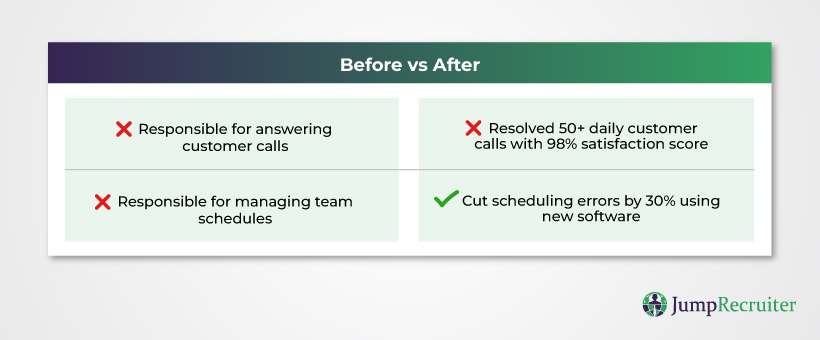
6. Overstated or Unrealistic Results
Recruiters can spot numbers that feel exaggerated. Claims like “Increased sales by 500% in one month” raise eyebrows unless you can back them up. Overblown results make hiring teams question your honesty.
How to Fix It:
- Be accurate and realistic. Use numbers you can explain in an interview.
- If you don’t have exact data, use safe phrases like “helped increase,” “supported growth,” or “contributed to.”
- Focus on context — explain how you achieved the result.
Playful Example:
Avoid: Doubled company revenue overnight.
Correct Way to Write : Increased revenue by 20% in Q1 through a new referral program.
This shows that you are credible, not just creative.
7. Design Errors That Distract Recruiters
Even a great resume can get ignored if it’s difficult to read. Messy design, tiny fonts, or inconsistent spacing make recruiters think you don’t care about detail.
How to Fix It:
- Use a clean, simple template with enough white space.
- Keep font size between 10–12 pt for text and 14–16 pt for headings.
- Align everything — dates, job titles, bullet points.
Save your resume as a PDF unless the job post says otherwise.
8. Typos and Grammar Errors
One typo can ruin a recruiter’s first impression. It signals carelessness and inattention — two things no employer wants.
How to Fix It:
- Proofread three times: once silently, once aloud, and once a day later.
- Use tools like Grammarly, but don’t rely only on them — ask a friend to review.
- Double-check that dates, headings, and bullet points look uniform across the whole resume.
9. Mismatched Information Across Platforms
If your LinkedIn profile says one thing and your resume says another, recruiters notice. Inconsistent job titles, dates, or company names create trust issues.
How to Fix It:
- Compare your resume with LinkedIn and other public profiles.
- Update them together whenever you change roles.
- Keep job titles and dates exactly the same to avoid confusion.
Example:
❌ Resume: Marketing Manager (Jan 2022 – May 2023)
❌ LinkedIn: Marketing Specialist (Feb 2022 – June 2023)
✅ Both updated to Marketing Manager (Feb 2022 – June 2023)
When your details match, it strengthens trust with recruiters.
10. Irrelevant Jobs Overloading the Resume
Including every job you ever had makes your resume too long and distracts from what matters. Recruiters only care about roles that relate to the job you want now.
How to Fix It:
- Focus on the last 10 years or most relevant roles.
- Use an “Other Experience” section for older or unrelated jobs.
- Keep your resume 1–2 pages max.
11. Oversharing Personal Info
Your resume is not your diary. Adding age, marital status, religion, or a photo (in most countries) can lead to bias and waste space.
How to Fix It:
- Include only professional details: name, phone, email, LinkedIn.
- Remove home address unless required.
- Skip personal photos unless they are standard in your region (such as in some parts of Europe or Asia).
12. Ignoring Application Instructions
When job postings require specific steps — such as attaching a PDF, naming the file correctly, or including a cover letter — they are testing attention to detail. Skipping these steps can result in immediate disqualification.
How to Fix It:
- Read the job posting twice before applying.
- Follow every instruction exactly, including file type and naming format.
- Use the keywords mentioned in the job ad to pass ATS filters.
13. Inflated Education or Fake Credentials
Lying about degrees, certifications, or skills is one of the fastest ways to lose a job offer. Employers often verify education and credentials.
How to Fix It:
- List only real, verifiable degrees and certifications.
- If something is in progress, label it clearly (e.g., “MBA — Expected May 2025”).
- Be ready to show proof if asked during the hiring process.
These last two steps are about trust. When you respect the employer’s process and tell the truth, you make it easy for them to respect you back.
When a Red Flag Is Forgivable (and How to Explain)
Not every red flag kills your chance outright. Sometimes, context, narrative, or explanation can neutralize it. But do it carefully.
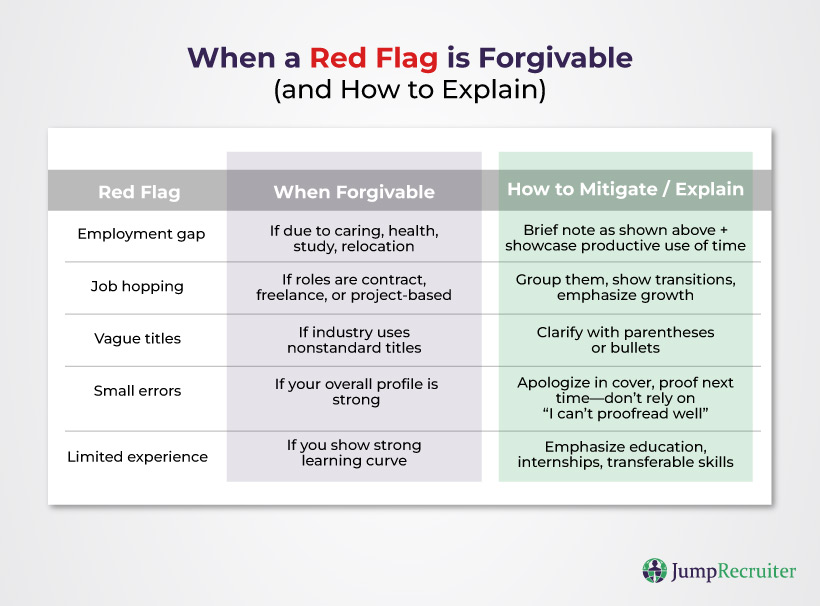
However, some red flags are rarely salvageable, including outright lies, mismatched stories, major discrepancies, and fake credentials. These erode trust.
Red-Flag Self Audit Checklist
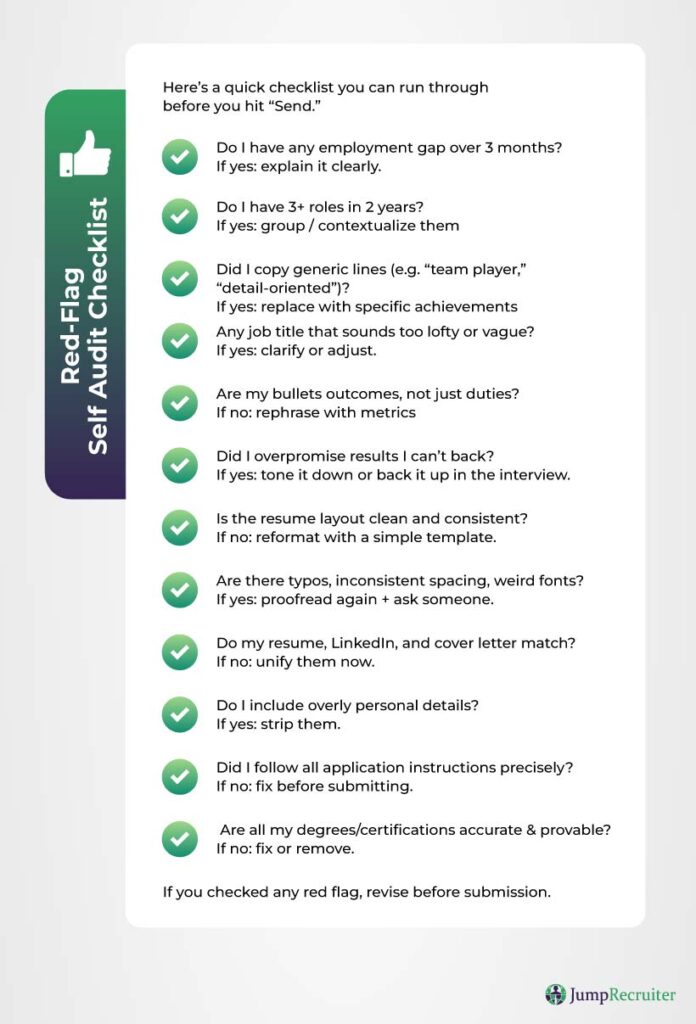
How Jump Resume Builder Can Help You Avoid Red Flags
At Jump Resume Builder, we make sure job seekers don’t get rejected for small, avoidable mistakes. Our platform is built to help you create a resume that clears every recruiter’s “red flag filter.”
Here’s how we help:
Quick Resume Builder: Upload your existing CV and get started fast.
Premium Templates: Sleek, professional designs that make you stand out instantly.
Multi-Profile Management: Build and manage different resumes for different industries or career stages.
Live Template Preview: See changes in real-time as you edit, with no surprises.
ATS-Friendly Resumes: Download formats that pass Applicant Tracking Systems without errors.
AI-Powered Suggestions: Get smart tips to refine bullets, highlight achievements, and avoid weak wording.
These features make Jump Resume Builder more than a tool — it’s your personal support system to stay clear of resume red flags.
Final Thoughts: Turn Red Flags Into Green Lights
At Jump Recruiter, we know how quickly a hiring decision can shift. Resumes that inspire trust get interviews. Resumes with red flags don’t. The good news? Every mistake on this list is fixable. With the right framing, numbers, and clarity, you can turn doubts into confidence.
And if you want a head start, our partner platform Jump Resume Builder can help you create professional, ATS-friendly resumes that clear recruiter filters from the start.
Because in the end, your resume isn’t just about getting noticed — it’s about being remembered for the right reasons.

